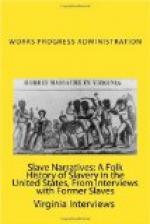Ouh for our
Mah for my
Ovah for over
Othuh for other
Wha for whar (where)
Undah for under
Fuh for for
Yondah for yonder
Moster for marster or massa
Gwainter for gwineter (going to)
Oman for woman
Ifn for iffen (if)
Fiuh or fiah for fire
Uz or uv or o’ for of
Poar for poor or po’
J’in for jine
Coase for cose
Utha for other
Yo’ for you
Gi’ for give
Cot for caught
Kin’ for kind
Cose for ’cause
Tho’t for thought
[Document 4]
WORKS PROGRESS ADMINISTRATION
Federal Writers’ Project
1500 Eye St. N.W.
Washington, D.C.
SUPPLEMENTARY INSTRUCTIONS #9-E
To
THE AMERICAN GUIDE MANUAL
FOLKLORE
STORIES FROM EX-SLAVES
Note: In some states it may be possible to locate only a very few ex-slaves, but an attempt should be made in every state. Interesting ex-slave data has recently been reported from Rhode Island, for instance.
April 22, 1937
STORIES FROM EX-SLAVES
The main purpose of these detailed and homely questions is to get the Negro interested in talking about the days of slavery. If he will talk freely, he should be encouraged to say what he pleases without reference to the questions. It should be remembered that the Federal Writers’ Project is not interested in taking sides on any question. The worker should not censor any material collected, regardless of its nature.
It will not be necessary, indeed it will probably be a mistake, to ask every person all of the questions. Any incidents or facts he can recall should be written down as nearly as possible just as he says them, but do not use dialect spelling so complicated that it may confuse the reader.
A second visit, a few days after the first one, is important, so that the worker may gather all the worthwhile recollections that the first talk has aroused.
Questions:
1. Where and when were you born?
2. Give the names of your father and mother. Where did they come from? Give names of your brothers and sisters. Tell about your life with them and describe your home and the “quarters.” Describe the beds and where you slept. Do you remember anything about your grandparents or any stories told you about them?
3. What work did you do in slavery days? Did you ever earn any money? How? What did you buy with this money?
4. What did you eat and how was it cooked? Any possums? Rabbits? Fish? What food did you like best? Did the slaves have their own gardens?




